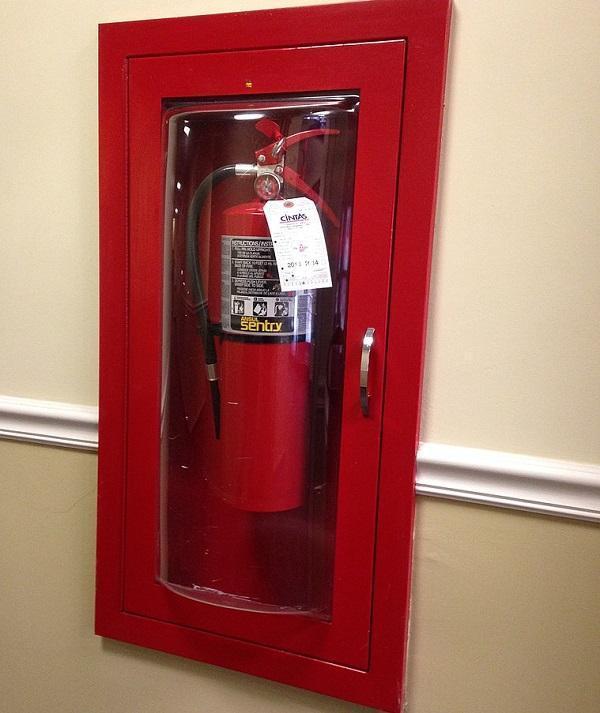One crucial aspect of fire safety is having accessible and properly placed fire extinguishers. But where exactly should these extinguishers be located in the office or workplace?
It’s important to note that fire extinguishers should be placed in easily accessible locations throughout the workplace. OSHA recommends that extinguishers be placed near exits and on each level of the building. This ensures that employees can quickly grab an extinguisher and evacuate the building if necessary. The rationale behind this is that in the event of a fire, every second counts and having the extinguisher near the exits and on each level of the building allows for quick access in case of emergency. It also makes it more likely that an employee will be able to reach an extinguisher in time to put out a small fire before it becomes a larger one. Conduct regular inspections of the workplace to ensure that extinguishers are easily accessible and placed near exits and on each level of the building. This includes checking for any obstructions that may block access to the extinguisher, such as furniture or equipment. It’s also important to make sure that the extinguisher is mounted at a height that is easy for employees to reach. In some cases, this may mean installing extinguishers on a wall-mounted bracket or in a cabinet with a breakable glass door to ensure easy access in case of emergency.
When it comes to specific areas of the office, it’s important to consider the potential fire hazards. For example, in a kitchen or break room, it’s crucial to have an extinguisher nearby in case of cooking fires. In a workshop or manufacturing area, extinguishers should be placed near flammable materials or equipment. The rationale behind this is that certain areas of the office or workplace may have a higher risk of fire and it’s important to have an extinguisher readily available in case of emergency. Conduct a fire risk assessment of the workplace and identify areas that may have a higher risk of fire. This includes identifying potential fire hazards such as flammable materials, electrical equipment, and cooking appliances. Once these areas have been identified, it’s important to place extinguishers in these areas to ensure that they are easily accessible in case of emergency. It’s also important to ensure that employees are aware of the location of the extinguisher and know how to use it properly.
It’s also important to consider the visibility of the extinguisher. Extinguishers should be placed in areas where they are easily spotted, with clear and visible signage indicating their location. In some cases, this may mean installing extinguishers in bright, contrasting colors to make them stand out. The rationale behind this is that in the event of an emergency, employees need to be able to quickly locate the extinguisher and it’s important for the extinguisher to be easily visible. Make sure that extinguishers are placed in areas where they are easily visible and that there is clear signage indicating their location. This includes installing extinguishers in bright, contrasting colors to make them stand out. It’s also important to regularly check that the extinguisher is visible and that the signage is still clear and legible. In addition, providing training to employees on how to locate the extinguisher in case of emergency is also crucial.
It’s not just the placement of extinguishers that’s important, but also their accessibility. Extinguishers should be mounted at a height that is easy for employees to reach, and they should be free of any obstructions that could block access. The rationale behind this is that in case of emergency, the extinguisher needs to be easily accessible and reachable for the employees to use it. Ensure that extinguishers are mounted at a height that is easy for employees to reach and that they are free of any obstructions that could block access.
Regularly inspecting the workplace for any potential obstructions and making sure that the extinguisher is mounted at the appropriate height is crucial. It’s also important to ensure that the extinguisher is not blocked by any furniture or equipment and that it is easily accessible. In some cases, this may mean installing extinguishers in a cabinet with a breakable glass door or on a wall-mounted bracket to ensure easy access in case of emergency.
Employees should also be trained on how to properly use the fire extinguisher. This includes knowing the different types of fires that each extinguisher can put out and how to operate the extinguisher properly. The rationale behind this is that in case of emergency, employees need to know how to properly use the extinguisher to ensure that they can safely put out a fire. Provide regular training to employees on how to properly use the fire extinguisher. This includes training on the different types of fires that each extinguisher can put out and how to operate the extinguisher properly. It’s also important to make sure that employees are aware of the location of the extinguisher and know how to use it in case of emergency. In addition, providing employees with a visual guide on how to use the extinguisher, such as a poster or brochure, can also be helpful.
In addition to the placement of fire extinguishers, it’s important to have a comprehensive evacuation plan in place. This includes emergency lighting, emergency exits, and designated assembly areas for employees to gather in case of emergency. The rationale behind this is that in case of emergency, employees need to know how to safely evacuate the building and where to gather. Have a comprehensive evacuation plan in place that includes emergency lighting, emergency exits, and designated assembly areas for employees to gather in case of emergency. It’s also important to regularly conduct evacuation drills to ensure that employees are familiar with the evacuation plan and know how to safely evacuate the building. In addition, making sure that employees are aware of the location of emergency exits and emergency lighting is also crucial.
Proper placement and accessibility of fire extinguishers in the workplace is crucial for protecting both employees and the building itself. It’s important to consider potential fire hazards, visibility, and accessibility when determining the best location for extinguishers. Regular training and a comprehensive evacuation plan are also crucial components of fire safety in the workplace. By keeping these factors in mind, we can help ensure that employees are prepared and able to safely evacuate in the event of a fire.


